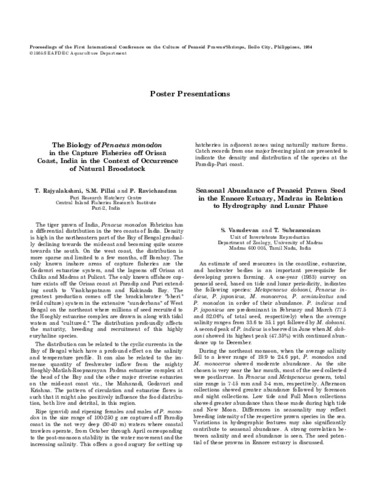The biology of Penaeus monodon in the capture fisheries off orissa coast, India in the context of occurrence of natural broodstock
- Global styles
- MLA
- Vancouver
- Elsevier - Harvard
- APA
- Help

Date
1985Page views
3,450ASFA keyword
AGROVOC keyword
Taxonomic term
Metadata
Show full item record
Share
Abstract
The tiger prawn of India, Penaeus monodon Fabricius has a differential distribution in the two coasts of India. Density is high in the northeastern part of the Bay of Bengal gradually declining towards the mid-east and becoming quite scarce towards the south. On the west coast, the distribution is more sparse and limited to a few months, off Bombay. The only known inshore areas of capture fisheries are the Godavari estuarine system, and the lagoons off Orissa at Chilka and Madras at Pulicat. The only known offshore capture exists off the Orissa coast at Paradip and Puri extending south to Visakhapatnam and Kakinada Bay. The greatest production comes off the brackishwater "bheri" (wild culture) system in the extensive "sunderbans" of West Bengal on the northeast where millions of seed recruited to the Hooghly estuarine complex are drawn in along with tidal waters and "cultured." The distribution profoundly affects the maturity, breeding and recruitment of this highly euryhaline species.
The distribution can be related to the cyclic currents in the Bay of Bengal which have a profound effect on the salinity and temperature profile. It can also be related to the immense quantity of freshwater inflow from the mighty Hooghly-Matlah-Roopnarayan Padma estuarine complex at the head of the Bay and the other major riverine estuaries on the mid-east coast viz., the Mahanadi, Godavari and Krishna. The pattern of circulation and estuarine flows is such that it might also positively influence the food distribution, both live and detrital, in this region.
Ripe (gravid) and ripening females and males of P. monodon in the size range of 100-250 g are captured off Paradip coast in the not very deep (30-40 m) waters where coastal trawlers operate, from October through April corresponding to the post-monsoon stability in the water movement and the increasing salinity. This offers a good augury for setting up hatcheries in adjacent zones using naturally mature forms. Catch records from one major freezing plant are presented to indicate the density and distribution of the species at the Paradip-Puri coast.
Description
Abstract only.
Suggested Citation
Rajyalakshmi, T., Pillai, S. M., & Ravichandran, P. (1985). The biology of Penaeus monodon in the capture fisheries of Orissa coast, India in the context of occurrence of natural broodstock (Abstract only). In Taki Y., Primavera J.H. and Llobrera J.A. (Eds.). Proceedings of the First International Conference on the Culture of Penaeid Prawns/Shrimps, 4-7 December 1984, Iloilo City, Philippines (p. 175). Iloilo City, Philippines: Aquaculture Department, Southeast Asian Fisheries Development Center.
Type
Conference posterISBN
9718511008
Related items
Showing items related by title, author, creator and subject.
-
An overview of the nutrition, feed and feeding techniques of prawn penaeid/shrimps
Piedad-Pascual, Felicitas (Philippine Council for Aquatic and Marine Research and Development, 1989)This paper echoes what transpired during the first International Conference of Penaeid Prawns/Shrimps held in Iloilo City in December 4-7, 1984, particularly on the Nutrition nd Feed Development. Around 25 papers were ... -
Series: Aquaculture extension manual; No. 19
Prawn hatchery operations
Parado-Estepa, Fe D.; Quinitio, Emilia T. ; Borlongan, Emeterio L. (Aquaculture Department, Southeast Asian Fisheries Development Center, 1996-05)
The manual, an updated version of the 1984 SEAFDEC/AQD manual, presents the underlying principles and step-by-step instructions of prawn larval and post-larval rearing. The techniques described are not only applicable to ...
; Borlongan, Emeterio L. (Aquaculture Department, Southeast Asian Fisheries Development Center, 1996-05)
The manual, an updated version of the 1984 SEAFDEC/AQD manual, presents the underlying principles and step-by-step instructions of prawn larval and post-larval rearing. The techniques described are not only applicable to ... -
The lowdown on world shrimp culture - II
Yap, Wilfredo G. (INFOFISH, 2001)This paper introduces some new members of the international shrimp culture club and goes on to discuss some recent technological innovations in the industry, particularly the polyculture of tilapia (mainly Oreochromis ...






